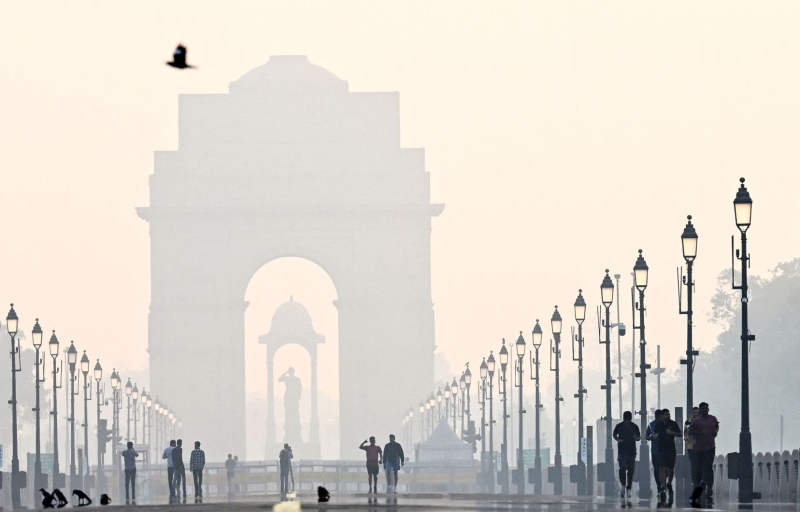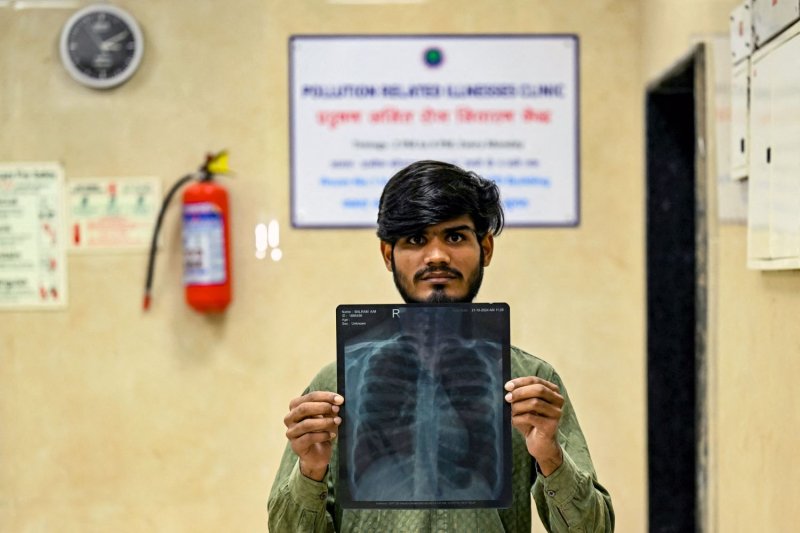
Photo: Arun Sankar Agence France-Presse Pedestrians walk through smog near India Gate in New Delhi on November 1, 2024.
Abhaya Srivastava – Agence France-Presse in New Delhi
Published at 10:24 a.m.
- Asia
“I can't get rid of my cough.” With a chest X-ray in his hand, Balram Kumar joined the line of victims of the smog that envelops the Indian capital every winter in front of a New Delhi hospital.
“I barely slept all night,” sighs the 24-year-old worker fatalistically as he waits outside the ward specially set up by the Ram Manohar Lohia Hospital to accommodate those suffering from breathing difficulties.
“My chest hurts every time I cough,” he describes. “I take medication, but it doesn't change anything.”
For years now, the Indian capital has consistently topped the list of the world's most polluted megacities.
In addition to the fumes from industries and vehicles, in winter they are also added to those from agricultural burning to create a thick toxic cloud that lower temperatures and weaker winds throw at the megacity and its 30 million inhabitants.
On Tuesday, the concentration of PM2.5 microparticles in the air — the most dangerous, because they spread into the blood — reached 278 micrograms per cubic meter, according to the AQI index.
A level 18 times higher than the maximum level deemed acceptable by the World Health Organization (WHO). On some days, it can exceed up to 30 times this threshold.

Photo: Money Sharma Agence France-Presse Balram Kumar holds his chest X-ray in a clinic specializing in the fight against pollution at the Ram Manohar Lohia Hospital in New Delhi.
Insufficient measures
The Indian government's many initiatives, such as a campaign suggesting that drivers turn off their engines at red lights, have failed to reduce the pollution that surrounds its capital.
And as if these factors were not enough, the thickness and noxiousness of the cloud covering New Delhi worsens even more during the Hindu festival of Diwali, when its residents celebrate the triumph of light over darkness with firecrackers and fireworks.
As head of the special clinic at Ram Manohar Lohia Hospital, Dr Amit Suri has observed a 20 to 25 per cent increase in the number of cases of respiratory ailments after Diwali.
“Most patients come with complaints of dry cough, sore throat or watery eyes. Some also suffer from skin rashes,” describes Dr. Suri.
To his patients, the doctor prescribes some medication, free of charge, and advice: keep the windows of your home closed, go out wearing a mask…
According to the WHO, air pollution can cause cardiovascular and respiratory diseases as well as lung cancer.
A study published in the medical journal Lancet attributed the deaths of 1.67 million Indians in 2019 to poor air quality.
Read also
- India, world champion of plastic pollution, according to a study
- New Delhi bets on seeding clouds to dispel pollution
“So devoid”
Another one, published in June in the Lancet Planetary Health Journal, estimated that pollution was responsible for 7% of deaths in India's 10 largest cities. In New Delhi, the figure rose to 11.5%, or 12,000 deaths a year.
Last month, the Supreme Court, the highest court in the world's most populous country, added clean air to its list of basic human rights and ordered the government to act accordingly.
To little effect. The ban on firecrackers decreed this year by the capital’s authorities has hardly been enforced…
“We need to raise awareness and do something because the problem is getting worse every day,” warns a hospital official, Dr Ajay Shukla, according to whom, on some days, breathing the air in New Delhi is as harmful as chain smoking.
Despite these frightening figures, a large part of the city’s population, with modest incomes and no health insurance, cannot afford to protect themselves.
“Doctors have asked me not to go out and breathe the polluted air, but how will I live if I don’t go out?,” asks Kanshi Ram, 65, a labourer whose severe cough has kept him from going to work these days. He earns 500 rupees [a little over eight Canadian dollars] a day.
“I feel so helpless,” he laments, “I don’t know what I have done to deserve this.”

